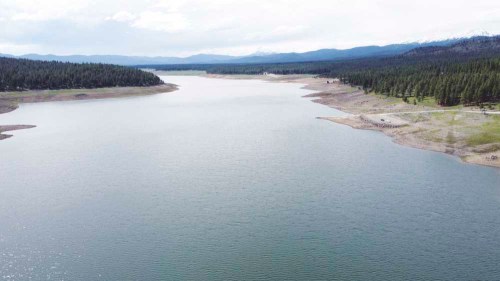Governor declares drought emergency in Baker County
Published 2:00 pm Monday, May 16, 2022

- Phillips Reservoir southwest of Baker City is holding about 12% of its capacity. This view, looking west from near Mason Dam, was taken by a drone on Sunday, May 15, 2022.
Oregon Gov. Kate Brown has declared a drought emergency in Baker County, granting a request that Baker County commissioners made on April 28.
Commissioners initially approved a drought disaster resolution on April 6.
Trending
On Friday, May 13, Brown issued an executive order declaring a drought emergency in Baker and three other counties — Wallowa, Wheeler and Douglas.
“Baker, Douglas, Wallowa, and Wheeler counties are facing historic challenges from drought conditions that are creating hardships for the people, farms, ranches, communities, and ecosystems of the region,” Brown said in a press release. “I am committed to doing everything possible to make state resources available to provide immediate relief and assistance to water users throughout Baker, Douglas, Wallowa, and Wheeler counties.”
The drought order gives the Oregon Water Resources Department more flexibility in allocating water, reviewing requests for wells and reducing state fees.
Drought declarations can also make property owners in the county eligible for financial aid and other assistance from the state and federal government.
County Commissioner Mark Bennett, who also owns a cattle ranch near Unity, in the southern part of the county, said on Monday, May 16, that one of the largest potential benefits of the governor’s drought declaration is that it allows farmers and ranchers more flexibility in where they divert irrigation water for which they have a legal right.
This is the second straight year Baker County commissioners, and Brown, have declared a drought disaster in the county.
Trending
The situation in the county has improved somewhat over the past month or so.
Since early April, a series of storms has brought significant amounts of rain and mountain snow to Baker County and the rest of Northeastern Oregon.
During April, 1.26 inches of precipitation was recorded at the Baker City Airport. It was the first month since May 2020 with more than an inch, and the wettest month since February 2019, when the total was 1.92.
The pattern, which is forecast to persist for at least the next week, has slightly eased the severity of the drought in Baker County.
On April 5, the U.S. Drought Monitor placed 84% of Baker County in extreme drought, the second-worst category in the five-level rating system, which ranges from abnormally dry to four drought ratings — moderate, severe, extreme and, the worst, exceptional.
As of May 10, the amount of land in Baker County rated as being in extreme drought had dropped from 84% to 62%. That swath included most of the central part of the county, including Baker Valley.
Almost the whole of the rest of the county is in severe drought, mostly in the eastern and western parts. A sliver at the far northwest part of the county — less than half of one percent of the county — was rated as moderate drought. That area is in the mountains and doesn’t include any farmland.
Bennett said rain and snow over the past month or so has spurred the growth of grass both in valleys and in forests where many ranchers have allotments to graze cattle during the late spring and summer.
But Bennett said he remains concerned that livestock forage, and hay crops, will diminish late in the summer unless the season is abnormally damp.
That would exacerbate the shortage of hay resulting from the 2021 drought, and the resulting high prices.
Despite recent storms, drought ratings in Baker County are worse now than they were a year ago.
In the second week of May 2021, just 16% of the county was in extreme drought — compared with the current 62% — with most of the rest in severe drought.
The northeast part of the county, including the Pine Valley around Halfway, was rated as abnormally dry, but not officially in drought, a year ago.
Conditions worsened through much of 2021 however. The year ended with 5.37 inches of precipitation at the Baker City Airport — slightly more than half of the annual average of 9.83 inches.
Watermaster’s office sees effect from recent rains
Marcy Osborn, Baker County watermaster, said the irrigation season started early.
She said her office started receiving requests for water in early April, about a month earlier than usual, following a winter with a below-average snowpack and much drier conditions in the valleys than is typical.
But Osborn said that with the weather turning damp over the past month, the number of calls from water rights holders has dropped significantly.
In Oregon, water is doled out based on the date on each individual right — landowners who have the oldest rights will keep receiving water when others have water shut off.
Osborn said she and other workers in the watermaster’s office respond to calls from people with water rights, checking the priority date on the right, the volume in the stream for which the right exists, and then adjusting headgates to divert the water as needed.





